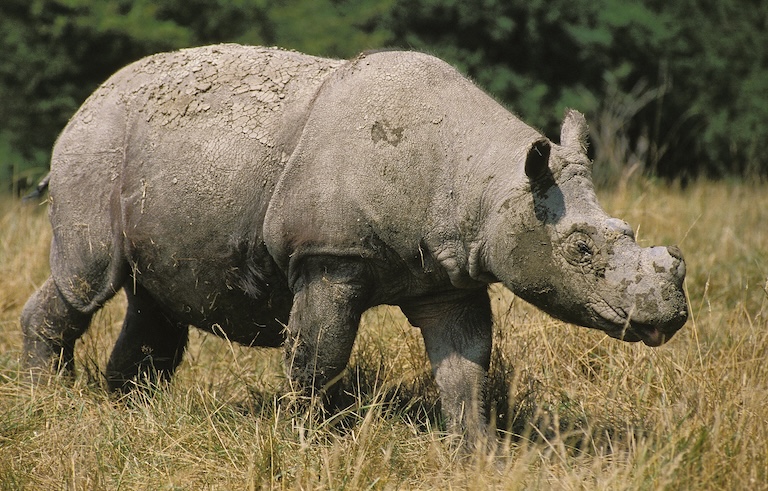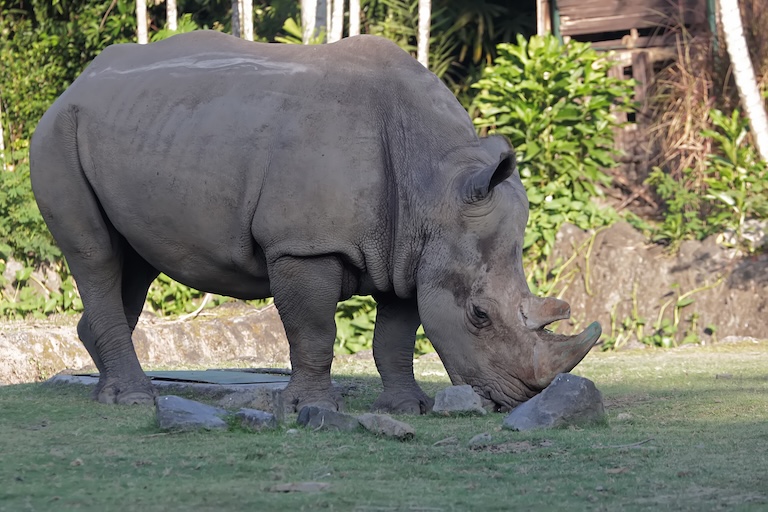Sumatran Rhinoceros Profile
For well over 250,000 years, our dead cousins, the Neanderthals, went up against behemoth woolly rhinos in Europe with just pointy sticks and commitment. Then, our dumbasses came along and stood at range, throwing spears, and quickly killed all the woolly rhinos and “bred” the Neanderthals out of existence, too.
Today, we have almost finished the job entirely: there is a rapidly dwindling population of Pleistocene megafauna left, and of the rhinos, one species, the Sumatran rhino, is the most endangered, but also the hairiest.

Sumatran Rhinoceros Facts Overview
| Habitat: | Dense tropical upland and lowland rainforest, swampy wetlands |
| Location: | Indonesia and Malaysia (Borneo) |
| Lifespan: | 35 years in captivity |
| Size: | Up to 4 metres long, 1.5 m tall |
| Weight: | Up to 1,000 kg |
| Colour: | Reddish-brown skin covered in long hair |
| Diet: | Saplings, leaves, twigs, and shoots |
| Predators: | None, other than humans |
| Top Speed: | 40 km/hr |
| No. of Species: | 1 |
| Conservation Status: | Critically Endangered |
We, H. sapiens, have really done a number on rhinos. Before we came along, they were found almost everywhere, and today, they’re one of the latest of the megafauna about to disappear. None more so than the Sumatran rhino, a dwindling remnant of a Eurasian icon and a victim of much the same pressure as its ancestors.
Pressure is now on our species to identify and correct the issues at hand, or risk losing the only remaining hairy rhino species in the world.
Interesting Sumatran Rhinoceros Facts
1. They’re tiny!
Rhinos are unusual animals. They are members of the “Other” ungulate order, the Perissodactyls. This was once a far more populated clade of tetrapod mammals that has since been totally overtaken by the overwhelming diversity of the even-toed ungulates in Artiodactyla.
Perissodactyla today is home to just the horses, tapirs and rhinos, and so is comprised of an enduring set of primitive ungulates that cut their teeth in the early days after the dinosaur extinction and ruled the earth for a long time after that.
Rhinos alone did very well until remarkably recently, peaking in diversity in the Miocene, during which time five or six species could be found overlapping in range at any one time in Eurasia; nine such in South Asia, and several in the Americas and Africa, too.
By the Late Pleistocene, rhinos were still widespread across Africa and Eurasia. But today, after tens of thousands of years of concentrated human hunting pressure, only five species remain, spattered among isolated populations in tiny pockets across a fraction of their old range.
The largest, the white rhino, reaches around 2.5 tonnes in weight, around that of the extinct woolly rhinoceros. The smallest, the Sumatran, sometimes reaches a tonne in weight, but more commonly sits at around 775 kg.
It is the only member of its genus, and the only member of a once grand clade called Dicerorhinini.

2. They’re woolly?
This species, despite being the smallest rhino, is a close relative of one of the largest. Sumatran rhinos are the closest living relatives of the up-to-three-tonne woolly monsters our prehistoric cousins sustained themselves on in Pleistocene Europe, and this might go some way to explain all the hair.
Sumatran rhinoceroses are also called hairy rhinoceroses, for what should be very obvious reasons, and newborns are covered in a reddish-brown fuzz which gets thinner and darker as they age.
This hair helps grip mud, which they can then carry around as sunscreen, thermal insulation, and protection against biting flies and other such environmental pests – something which the woolly rhinos of old would also have done on the wet and mosquito-infested Steppe, not too long ago.
3. They’re solitary
African white rhinos are probably the most social of the rhino species, but there is a low bar for entry in this category, as even they are mostly solitary, and are really only found in small groups of females, sometimes.
So, Sumatran rhinos aren’t unusual in their social structures, really, and males are exclusively solitary, but overlap in their territories with females. Females are almost solitary, but can be found with kids quite often, as their offspring do take a long time to mature, and this leads us neatly into the plight of this species as a whole.
4. They reproduce slowly
As animal bloggers, we don’t spend a lot of time around human women, but it’s assumed Sumatran rhino mating routines are much the same as our own: females indicate they want some by making a lot of noise and spraying urine everywhere. Males then locate the female by the smell, and stick their nose into her butt. With this elaborate courtship ritual complete, they copulate.
Where reproduction differs from ours is in the gestation period. These small rhinos can bake their buns for up to 16 months, and will only give birth to a single calf. Further, females won’t even become receptive unless they smell a male nearby, and won’t reach sexual maturity until 7 or even 10 years of age.
With all this in mind, reproduction cycles are 3 to 4 years, and offspring are dependent for 2 to 3 of these. But this is such an exceptionally rare and secretive animal that mating in this species has only been witnessed in captivity.
5. The Allee Effect
Being mostly solitary means that these animals have low population densities. And with a low density and a shrinking habitat, this logically creates low overall numbers, as well.
Population growth in many low-density species is limited by undercrowding even more than competition, and back in the ‘20s, a guy called Allee discovered this principle in isopods (which are, admittedly, quite different from rhinos). This effect, now called the Allee Effect, has since become recognised as a fundamental law of ecology, at least for species in which population size relates to reproductive fitness.
Basically, this runs counter to the intuition that a low population should experience higher growth rates, given an absence of competition and an abundance of resources. And this goes some way to explaining the dire straits that Sumatran rhinos are facing as their numbers dwindle further. 1
6. They’re almost all gone
We can’t blame the Sumatran rhino’s imminent extinction purely on ecological fundamentals, though.
The low populations creating this negative feedback loop are entirely our doing, and human-caused habitat destruction and poaching provide the two other features of this destructive trifecta that is wiping out the species. Human hunting provides the only threat of predation for this species, which is more than capable of protecting itself against everything else.
There are now only 4 populations left in Indonesia, and only one of these is believed to have enough genetic diversity to be viable in the long term. What this means is that all but one population of Sumatran rhinos may be considered functionally extinct, unless we do something about it.
And people are trying, but the behaviour and physiology of these rhinos make things complicated. 2 3
7. Breeding programs are struggling
In 2016, there was a total of three Sumatran rhinos left in Malaysia. All were in captivity. By 2019, they were all dead.
A handful remained in Rhino sanctuaries in Indonesia, and from these, we get the majority of the primary literature on the species. Local wisdom talks romantically of these little rhinos eating fire and attacking campers to get to it. Tales also tell of these rhinos congregating beneath the full moon.
But more rigorous research illuminates the bleaker truths about these rhinos: the females who don’t get a chance to breed have a tendency to suffer from reproductive issues as a result. Ultimately, the cause of the Allee effect appears to be the nature of this species’ reproductive biology.
Almost akin to an autoimmune disorder, females can become infertile or otherwise suffer diseases of their reproductive systems if they go too long without getting pregnant. And so, sadly, wild-caught females from small, declining populations are often incapable of supporting the species in captivity. 4

Sumatran Rhinoceros Fact-File Summary
Scientific Classification
| Kingdom: | Animalia |
| Phylum: | Chordata |
| Class: | Mammalia |
| Order: | Perissodactyla |
| Family: | Rhinocerotidae |
| Genus: | Dicerorhinus |
| Species Name: | sumatrensis |
Fact Sources & References
- Drake et.al (2011), “Allee Effects”, The Nature Education.
- (2020), “Sumatran Rhino”, International Rhino Foundation.
- National Geographic , “Sumatran Rhinos Are Nearly Gone—New Plan Launched to Save Them”, YouTube.
- Schaffer et. al (2020), “Ramifications of reproductive diseases on the recovery of the Sumatran Rhinoceros Dicerorhinus sumatrensis (Mammalia: Perissodactyla: Rhinocerotidae) ”, Journal of Threatened Taxa.
